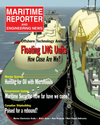
Page 25: of Maritime Reporter Magazine (April 2005)
The Offshore Industry Anual
Read this page in Pdf, Flash or Html5 edition of April 2005 Maritime Reporter Magazine
• Strong import demand Many of the major gas-consuming nations of the world have either very little gas produc- tion of their own (e.g. Japan, South
Korea) or have developed and drawn down their own reserves to the point where they are now past peak produc- tion and will have to increasingly rely on imported gas (e.g. USA, UK). Monetization of stranded gas reserves Significant amounts of natural gas reserves are located a long distance from the end market, or have no nearby pipeline infrastructure. Without access to markets, the produced gas is either flared or re-injected. LNG offers an access mechanism, a method of mone- tizing these gas reserves and reducing the environmental impact that is associ- ated with gas flaring. Technological advances Advances in liquefaction technology have led to a fall in the level of capital expenditure that is required to construct new plants.
LNG carrier prices have also fallen dra- matically. This reduced cost of LNG developments opens up opportunities to employ LNG technology where previ- ously it might have been considered economically unviable.
LNG Carriers
There are currently more than 170
LNG tankers in operation. Only a small number of shipyards are capable of building LNG tankers, due to the com- plexity of the vessels and the high levels of quality control required. They are by far the most expensive type of cargo vessel, costing around three times the price of an oil tanker of similar tonnage.
Figure 2 (left) shows the development of the LNG carrier fleet.
In the past, it has been normal practice for vessels to be dedicated to particular projects on long-term contracts, but spot trading is emerging as an increasingly significant element and is now thought to account for around 11 percent of total
LNG trade.
There are three main types of vessel design that have evolved and are cur- rently in use; the Kvaerner-Moss
Spherical System, the Gaz Transport
Technigaz (GTT) membrane type, and
IHI's Structural Prismatic design. The
Membrane system is the most widely adopted and is used in around 48 percent of the current vessels in service. The
Kvaerner-Moss spherical system accounts for 47 percent of containment systems in use
Capital Expenditure:
Trends and Forecasts
Figure 3 (on page 29) shows the levels of capital expenditure that we forecast will be required to complete new LNG facilities over the 2005-2009 period.
The dates refer to the year of start-up for the terminal. In practice, however, the contractual payments relating to the projects identified will often be made in installments and will most likely be spread over a number of years, not con- fined to a single year. For the sake of clarity and transparency we do not
As a leading global provider of a full range of remote IP data, and voice communications solutions, Stratos delivers the newest and most advanced satellite technologies.
StratosITek™ satellite broadband combines the convenience of always-on connectivity and the power of broadband to support a host of IP-based applications. With coverage in multiple regions throughout the world, StratosITek delivers business-grade broadband for a single monthly service cost – no per minute charges.
Stratos now also offers the revolutionary new Fleet family of marine products designed for those with a need for superior fax and data applications.
Fleet offers Inmarsat reliability, global coverage and a family of products featuring superior fax and multiple-speed data services, in addition to global voice.
Contact us today to find out more about our reliable maritime communications solutions.
General Enquiries: Phone: +1 709 748 4233
Toll-Free: 1 888 766 1313 E-mail: [email protected] www.stratosglobal.com superior maritime communications
StratosITek ™ • Fixed, transportable and stabilized terminals • Always-on speeds up to several Mbps • Secure Internet, intranet, e-mail, VoIP, video conferencing • Low-cost alternative to traditional VSAT
Fleet • 64 kbps fax • 64 kbps data • new MPDS service • always-on, pay by the byte
Come see us at OTC ’05
Booth 4075
Offshore Technology Annual
Circle 296 on Reader Service Card
April 2005 25
Over the next five years we anticipate that over 120 new carriers will be constructed.
Capital expenditure associ- ated with these new vessels is forecast to be nearly $22 billion.
MR APRIL 2005 #4 (25-32).qxd 4/1/2005 3:47 PM Page 25

 24
24

 26
26
